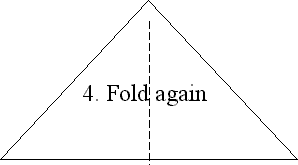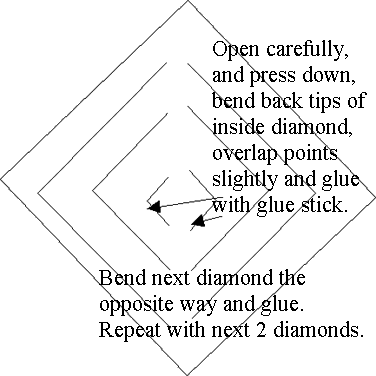 Classroom Crafts
Classroom Crafts
by The Teachers.Net Community
3D Snowflake
by mizletts




Make 3 cuts on the single fold toward the 2 folded sides staying 1" away from the edge and about 1" apart.

6.

This completes one cell, like this.

Make 5 more cells the same as described above. Glue or staple the ends of 3 cells together. Do the same with the other 3 cells. Then glue or staple those ends together facing opposite directions. Then glue or staple all sides together at the middle. Punch a hole in one point, add string.
Here is a picture of a completed snowflake.

Volcano!
by MaryAnn F. Kohl
Printed with permission from ScienceArts (MaryAnn Kohl, Bright Ring Publishing)
soda bottle, baking pan, moist soil 1 tablespoon of baking soda
1 cup vinegar
red food coloring
Place the baking pan on the grass, and set the soda bottle in the center of the pan. Mound and shape the moist soil or sand around the bottle to form a mountain volcano. Bring the soil right up to the top of the bottle opening, but not inside the bottle. Pour 1 T. baking soda into the bottle. Color 1 cup vinegar, and pour it into the bottle. Stand back and watch the red foam spray out the top and down the sides of the volcano.
Make individual "mini volcanoes" in film canisters.
Stand Outs
by MaryAnn F. Kohl
Printed with permission from MathArts, Gryphon House, by MaryAnn Kohl and Cindy Gainer.
Materials:
2 issues of the same magazines
scissors
glue
small pieces of sponge
cardboard
Procedure:
Select a picture in the magazine that has some interesting objects in it. Cut the picture selected out of both magazines. Glue one picture to the paper. Carefully cut the interesting objects out of the second picture. Glue these pictures on cardboard randomly. Allow the glue to dry for several minutes. Cut the pictures out of the cardboard. Glue tiny pieces of sponge t the center back of each object. Let the glue dry well. Glue the pictures of objects with the sponge on then over top of the ones on the whole picture. Hang the picture eye level on the wall and see how they stand out.
Dig It Sponge Art
by MaryAnn F. Kohl
Printed with permission from MathArts, Gryphon House, by MaryAnn Kohl and Cindy Gainer.
Materials:
small holes household sponges (not natural) scissors
tempera paint
paper
Procedure:
- Cut the sponge in a different shape such as a character or simply a random shape.
- Cut design holes inside the sponge.
- Wet the sponge in the paints.
- Make sponge imprints on the paper.
- Make several other sponge shapes using the sample technique.
- Make a picture out of the sponge prints.
Soap Balls
are a nice little gift for kids to make
by MaryAnn F. Kohl
(reprinted with permission from Mudworks, by MaryAnn Kohl, Bright Ring Publishing)
Pour 2 cups Ivory Snow detergent into a bowl. Add water mixed with food coloring, mixing it in with hands, until the soap forms a ball . Usually about 2 tablespoons does the job. Add more water if necessary.
Form into balls. Wrap with plastic wrap and tie with a ribbon, or wrap in a washcloth, attach to a sponge, or any bath supplies to make a cute gift.
Note: You can also melt down old left-over bits of soap in a sauce pan with a little water. Then form balls by hand with the slightly cooled soap moosh.
Magic Cabbage
by MaryAnn F. Kohl
printed with permission from Science Arts, by MaryAnn Kohl and Jean Potter, Bright Ring Publishing
Materials
fresh red cabbage
knife
pot
stove
water
strainer
bowl
paintbrush
white paper
vinegar
adult help
Art Experiment
- Cut the cabbage into small pieces with a knife.
- Fill a pot half full of water and put the cabbage pieces in it.
- Adult step: Put the pot on the stove and bring to a boil. Boil for about one minute. Then remove it from the heat.
- Let the pot set for about 20 minutes.
- Strain the colored cabbage water into a bowl. Set the cabbage aside to eat later.
- With a paintbrush, use the colored cabbage juice to make a picture on the paper.
- Let the cabbage juice painting dry completely.
- Next, brush a little vinegar on the painting to reveal the magic picture. The juice should turn from purple to pink.
Note to Adult:
Many common foods like vinegar and lemon have a sour taste and are called ACIDS. Other foods like milk and baking soda are called BASES. Cabbage juice is an ACID/BASE INDICATOR which means that it will determine the acid/base level of a substance by changing color. When vinegar touches the cabbage juice painting, the purple painting changes to pink indicating that vinegar is an acid.
MaryAnn F. Kohl
Bright Ring Publishing, Inc.
PO Box 31338
Bellingham, WA 98228-3338
360.398.9801
fax 360-383-0001
maryann@brightring.com
http://www.brightring.com
Check out the latest buzz in the Project Center...
| 
